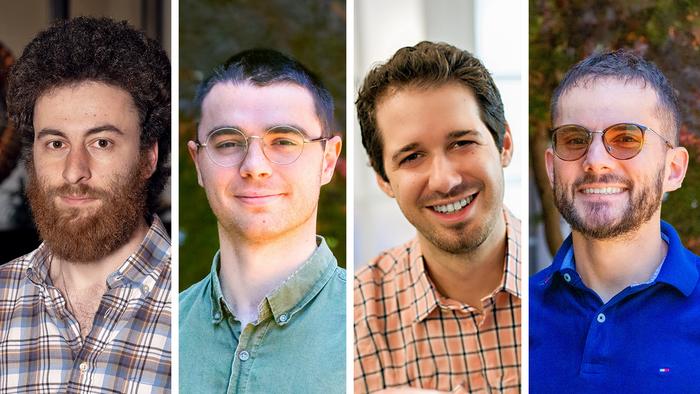The U.S. Department of Energy’s Princeton Plasma Physics Laboratory (PPPL) made a strong showing in this year’s Early Career Collection from the scientific journal Physics of Plasmas. The collection represents the top papers from all areas of plasma physics research authored by people who defended their dissertations less than five years before the journal article was submitted.

Credit: Photo credit (left to right): Elle Starkman, Michael Livingston, Ariel Mitnick, Michael Livingston
The U.S. Department of Energy’s Princeton Plasma Physics Laboratory (PPPL) made a strong showing in this year’s Early Career Collection from the scientific journal Physics of Plasmas. The collection represents the top papers from all areas of plasma physics research authored by people who defended their dissertations less than five years before the journal article was submitted.
“The first authors of the pieces in the 2023 Early Career Collection have made a notable contribution to the field of plasma and show significant promise. I look forward to reading more of their work in the future,” said Igor Kaganovich, principal research physicist at PPPL and senior associate editor at Physics of Plasmas.
PPPL’s important work seeding the field of plasma physics was evident from the list of first authors, which included the following four people from the Lab:
- Ben Israeli for his paper “Resonant Instabilities Mediated by Drag and Electrostatic Interactions in Laboratory and Astrophysical Dusty Plasmas.”
- Stephen Majeski for his paper “Super-Fermi Acceleration in Multiscale MHD Reconnection.”
- Ian Ochs for his papers “Ponderomotive Recoil for Electromagnetic Waves” and “Confinement Time and Ambipolar Potential in a Relativistic Mirror-confined Plasma.”
- Willca Villafana for his paper “3D Particle-in-Cell Study of the Electron Drift Instability in a Hall Thruster Using Unstructured Grids.”
“It was a great surprise to be included,” said Villafana. “This kind of recognition from the community encourages you to do more good work.”
Israeli noted it is often more difficult for early career researchers to disseminate their ideas, as their networks are often smaller. “Highlighting the work of early career researchers helps to balance this,” he said.
Majeski, who will defend his dissertation next spring, said a collection like this one is important in the world of physics because it helps younger scientists promote their work. “Research benefits a lot from momentum, which can be hard to build. Opportunities like this early on can really help get something started,” he said. “It encourages others in the field to take a closer look at ideas or work they may not have considered before.”
Ochs offered advice to newcomers to the field of plasma physics. “People often come to plasma physics for the dream of harnessing nuclear fusion energy, and then become embroiled in a love-hate relationship with a discipline that contains both models of great mathematical beauty and a billion details, which mess up each of those models,” he explained. “I would advise people starting out to remember why they came to the field, to choose a mentor they trust and work well with, to choose projects they find both interesting and useful and to try to avoid rabbit holes while not being afraid to explore side applications and systems that arise naturally in the course of their research.” Finally, Ochs said not to get discouraged if a project does not yield fantastic results. “The frontier of knowledge is unpredictable.”
Haomin Sun, formerly of PPPL, was also included in the collection, as well as Nakul Nuwal, who collaborated with PPPL through the Princeton Collaborative Low Temperature Plasma Research Facility.
Physics of Plasmas editorial board members determine which pieces will be included in the Early Career Collection. The collection was first published in 2022.
PPPL is mastering the art of using plasma — the fourth state of matter — to solve some of the world’s toughest science and technology challenges. Nestled on Princeton University’s Forrestal Campus in Plainsboro, New Jersey, our research ignites innovation in a range of applications including fusion energy, nanoscale fabrication, quantum materials and devices, and sustainability science. The University manages the Laboratory for the U.S. Department of Energy’s Office of Science, which is the nation’s single largest supporter of basic research in the physical sciences. Feel the heat at https://energy.gov/science and https://www.pppl.gov.





